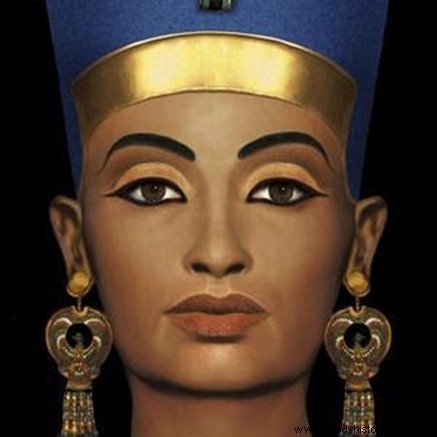I turn the knob on my time machine and set it to “Ancient Egypt”, I grit my teeth and… I appear in the middle of nowhere in a comfortable white robe and in my right hand a bunch of flax with spectacular blue flowers, as if was waiting for the bride by the altar. But there was no altar. In fact, there was nothing, just sand and more sand. With the palm of my hand over my eyes to shield myself from the sun, I scanned the horizon until I saw, in the distance, a cloud of dust moving towards my position. As they got closer, I could make out the silhouette of six people and mounts, one of them without a rider. I put the bouquet in front of me, by way of introduction, and breathed a sigh of relief when I saw that the rider had a bouquet in his hand similar to mine. I appreciated the skill of the sculptor who made the carving of Pehernefer that is in the Louvre museum, because it was an exact copy of the scribe who came looking for me and who would be my host. They helped him off the donkey and he walked towards me repeating the ritual I had done with the linen. And here I pulled on Herodotus, and repeated the greeting that he indicated in the second book of his work Historia :I leaned my body lowering my hands to the knee and looked at the scribe's shadow to see what he was doing. Bingo! He repeated the ritual.
Welcome Javier, I'm Pehernefer, royal scribe. You are my guest, come with me -I listened as I raised my head and a member of that entourage offered me his help to get on the other donkey.

Pehernefer
We turned and started back the way they had come. The scribe's mount came up next to mine and he asked me if he had seen any blue as intense as that of those flowers. Logically, my answer, because it was clear that he wanted to tell me a story, was no.
– In nature it is very difficult to find this color, just some flowers and bird feathers, but we have been able to artificially create this pigment that we use in tombs and sculptures. To obtain it, we mix crushed seashells, copper and sand from the Nile, and heat it to a temperature of approximately 900º for several hours. After letting the compound cool down, we take it out of the container and crush it until it pulverizes –he told me proudly.
– It must be the first pigment created artificially – I answered giving him an imaginary pat on the back.
The scribe extended his arm and with his index finger pointed to what I understood to be our destination:a rectangular adobe construction and several smaller ones around it at the foot of some rocks. I nodded and was grateful that the donkey ride was over. Pehernefer invited me to go to the patio of the big house and once inside he gave instructions to bring kohl and served us a beer on top. It was clear that, for one reason or another, my trips to the past began with a drink and something to put in my mouth. We went up to the upper room and I was grateful for the shade of that place and, above all, the strangely cool atmosphere in the middle of that dry land. And I asked about it…
- How good it is in this room! I suppose that, given the orientation of the house, the rocks protect the upper part from the sun.
-That's right. In addition, that window is covered with a damp palm mat and the warm breeze produces evaporation and in this way the interior of the room is cooled.
-And what is that clay container on the mat for? ? -I asked as the servants entered with a tray with the beer and a bowl that, I assumed, would be the kohl to eat.
-If you look for a moment you will see that it has holes, so it drips on the mat and keeps it moist so that it continues to evaporate and cool.
After checking that the Egyptians had their particular air conditioning, we were served beer. A beer nothing like the one my palate was used to. It was cloudy, almost reddish in color, and so thick it could almost have been spread on bread. And as I am one of those who think that “wherever you go, do what you see”, I put on the best of smiles and had a drink. He didn't know if he was drinking or eating, but it was what it was. When I put the beer on the table, the scribe held out his hand as if to pour myself the kohl. It was a blackish, resinous substance, not at all appetizing. In the absence of any kind of utensil with which to catch it, I put two fingers in, took a good amount and put it in my mouth...
-What are you doing! It's Kohl! the scribe yelled as he held my hand, as he began to laugh out loud.
I guess my surprised face made it clear to him that he should continue and explain to me what that was.
-It is a compound based on crushed galena mineral mixed with resin. We put it around our eyes to repel insects, reduce the reflection of the sun, and also help the eyelids protect the eyes by trapping sand particles. It seems to me that I am going to have to watch you very closely so as not to have any setbacks during your stay with us.
While I apologized for my stupidity, I followed the steps that my host indicated and made up my eyes with that ophthalmic ointment. When he gave me the okay, I took a drink of beer that lasted as long as I could to avoid, even if it was only for a few seconds, that mocking and condescending look. Pehernefer seemed to realize that he was making me feel uncomfortable and lowered the tension by asking me where I wanted to start my visit.
-If it's not a problem, I'd like to start by visiting the construction of what will be the burial place of Pharaoh Khufu - I answered naming the pharaoh by his Egyptian name and not the Cheops name that Herodotus gave him.
-As you well know, I am in charge of supervising the burial work of Pharaoh Khufu, god of the Sun, so I will show you.
She had chosen him as her host because she knew of his role and because he was powerful enough in that society to be able to act without prohibition. We left the house and used the donkeys again to travel the path to what was to be the Great Pyramid. Barely ten minutes later, Pehernefer told me to dismount and walk to a mound on our right.
-Before going down to the valley, go up and contemplate from above the views of the largest construction ever built by man. We will wait for you here.
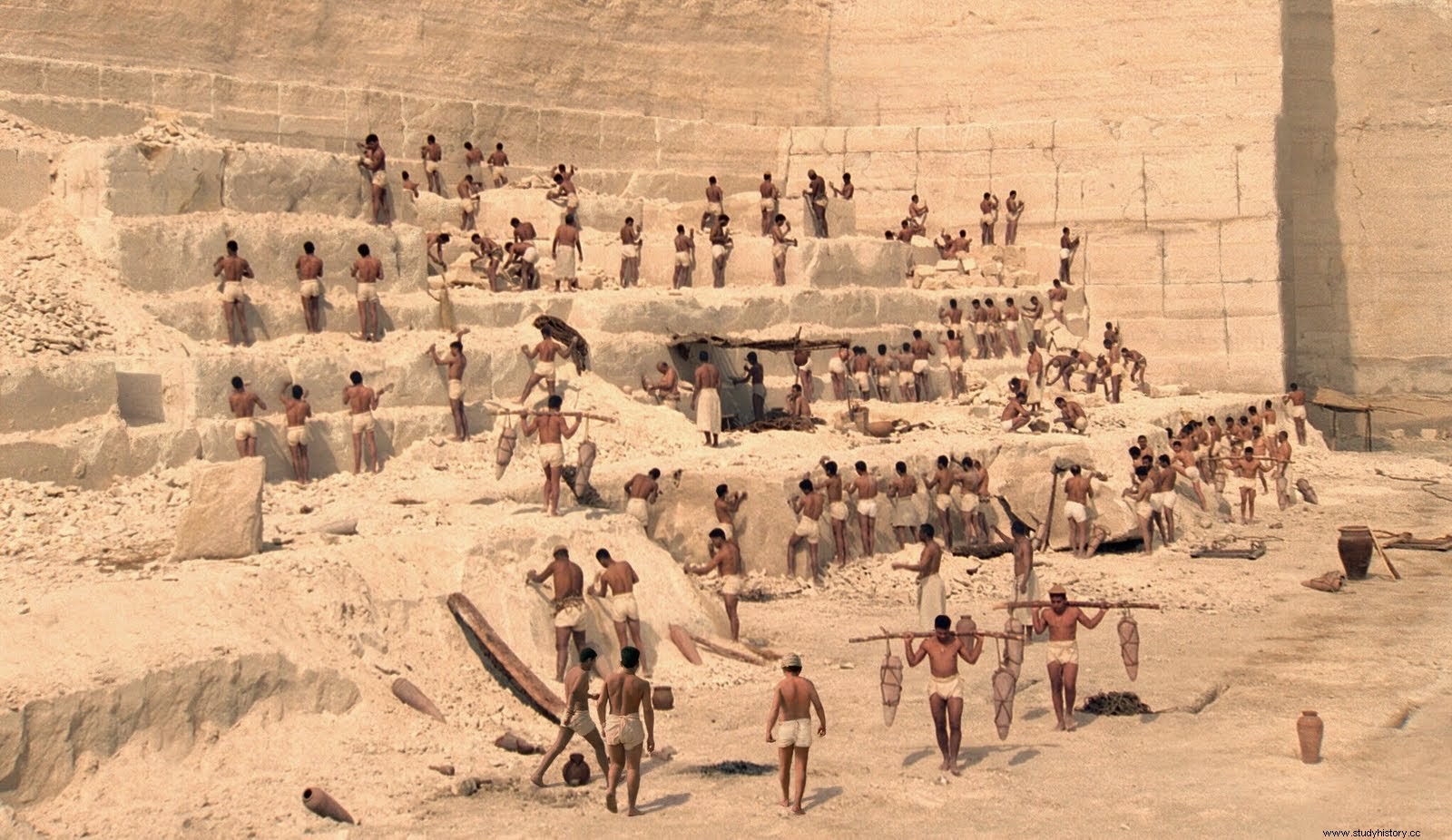
Logically, I obeyed the instructions of the scribe. Upon reaching the small summit, the only way I found to describe what I had at my feet was to plagiarize Isabel Allende “The sky cleared and the overwhelming beauty of the landscape arose before my eyes like a newborn world ”. Lacking a camera to immortalize that moment, I hit the record button in my brain while my retina tried to capture every detail:the Nile on one side, the quarry on the other, and the pyramid under construction in front of it. It was a postcard that conveyed organization and teamwork. I turned my head towards the retinue with a face of admiration and the scribe nodded proudly as if to say "I told you so". I went back to them and we walked down the path until we reached the quarry. There he took the floor Pehernefer to begin his speech…
-In this limestone quarry, most of the material necessary for the construction of the funerary monument is extracted. The stone blocks are carried to the foot of the ramp on these wooden sledges. You will see that a worker walks in front of the sled moistening the earth as it passes, in this way the sand is compacted, it becomes firmer and the force necessary to move them is reduced by half. And they go up the ramp to the corresponding row of blocks. Right now the ramp reaches a height of just over 40 meters, and although the final height will be 146 meters, the construction already has almost 80% of its total volume. The rest of the necessary material, such as granite for example, comes through the Nile. It arrives in large ships to the port and there it is unloaded in small boats that are towed through artificial channels to get as close as possible to the pyramid. What do you think?
-Well, I am still surprised by the majesty of a monument that, at its feet, makes me feel insignificant, by the perfect organization of the slaves, by the mastery of the architects and the ingenuity that you show to build a work of this magnitude.
-Thank you very much for your words, but… why did you speak of the “perfect organization of the slaves”? There are no slaves here. Do you see someone whipping or hitting those who work? They are paid workers. If you want you can talk to them and ask whoever you want.
I hesitated for a moment about asking any of the workers, but that would have been questioning the scribe's word and I didn't think it was a good idea. So, I declined the invitation.
-Nerd. Needless. It's just what I thought.
-The workers are organized by groups of about 40 to 60 people that can increase at specific times. Each one is directed by a foreman and at the head of all of them are the architects. And my job is to monitor the status of the works and report to my lord Khufu. Come, he will show you the documents in which everything related to this construction is written down.
On a table where there was a model of the pyramid, Pehernefer selected some papyri and spread them out.
-Look, here you write down the material that is extracted from the quarry and the one that arrives on the ships, the one that is used every day, the wages of the workers and the food they consume, the incidents at work... Everything you can imagine is detailed here. I don't know if your face of astonishment is because of all the details we record or because we don't write with hieroglyphs and you don't understand anything.
-I understand that without this meticulous accounting work it would be impossible to undertake a project of this magnitude, but the writing is unintelligible to me -I answered with the silly face that was already repeated too much in these trips to the past.
-It is hieratic writing. We scribes use it especially in administrative texts and it allows us to write quickly, simplifying hieroglyphs. I'll read you one of the papyri. For example, this one that will be curious and will confirm that they are not slaves:"Incidences and absences".Badru worker:absence due to death of a son.
Aswad worker:absence due to scorpion sting. Pending medical visit.
Ebo worker:he fell and hit his back. Transferred to the doctor while waiting for days off.
Fadil worker:absence due to the need to brew beer for a celebration.
Hamadi worker:absence due to drunkenness.
Jabari worker:absence due to, According to him, he is recovering from a beating by his wife in a marital argument.
Worker Kafele:faints during work. Transferred to doctor. Tomorrow you will be able to go back to work... And many more incidents that I will ignore so as not to bore you. Do you think that if they were slaves they would have medical assistance and that they could be absent from work for these reasons?
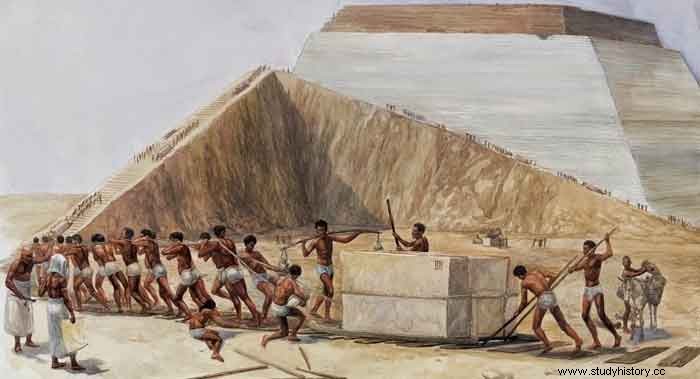
Faced with this devastating evidence, he could no longer deny the evidence:the builders of the pyramids were free workers, specialized and hired for a salary.
-Logically, the objective of this mega-construction is none other than to house the mummified body of your lord Khufu when he dies, but what are the rest of the burials like, are they also embalmed? -I asked, diverting the conversation towards embalming since, much to my regret, the subject of the pyramids seemed to be settled.
-Let's go to the city of workers, have some dates and beer and I'll tell you -answered my host while pointing out my usual mode of transportation.
As we headed to the town that the scribe had called "the city of builders", one of the companions approached to whisper something in his ear. He gave the appropriate instructions for the rest of my companions and apologized because he had to be absent for a moment. I sat where I was told, next to an adobe house under the shade of an awning, and waited. That place was full of life, people from here to there going about their daily chores, butchers working on butchering the slaughtered animals, the smell of freshly baked bread… the workers of the pharaoh's mausoleum lived here. Of all the buildings, the vast majority of which have only one floor, one of them caught my attention due to its size and the hustle and bustle of people coming and going. Seeing the conditions of those who entered, almost all of them helped by others, and some cries that escaped from inside, I assumed that it was the place where the wounded were treated. At that moment, I felt a hand on my shoulder…
-Forgive my absence, but I have been informed of an accident with several injuries and we had to replace them with another crew that was resting. Now they will bring them to serve them in that building -commented the scribe while they served us beer and some dates-. Well, you were asking me about the rest of the burials, right?
-That's right -I replied as I took one of those appetizing dates
-Before, I'll tell you that for us death is not an end point in the path, is just a comma. Here only our physical body remains; the Ka, our vital energy, leaves our body to travel to the Beyond. Of course, as long as your actions and your works in this life are enough to overcome the Judgment of the Dead. It is not an easy journey to the kingdom of Osiris, dangers lie in wait and the Ka must continue to feed, that is why offerings of food, drink and amulets are made to help in transit.
-Then why do they mummify themselves? the bodies if they do not accompany you on this journey? -I dared to ask, interrupting the scribe.
-Logically, our physical body cannot accompany us, but the Ba can, which makes each one of us characteristic, and with the ritual of opening the mouth release the Ba that, in the form of a bird, will fly to join the Ka and create the Akh that will live eternally in the kingdom of Osiris. By embalming our bodies, our essence is maintained, what characterizes us, and in this way it is a Ka identical to that of this world. In addition to food and amulets for the trip, once the Akh is in the Beyond, he will need goods and utensils for the afterlife, that is why clothes, furniture, tools, jewelry are also deposited next to the sarcophagus...
-And are they all embalmed? -I asked already stuck in flour
-The burial and embalming depends, like almost everything in life, on the possibilities of the deceased and his family. As you have already seen, the pharaohs are buried in these megalithic constructions and are mummified by extracting their viscera, except for the heart, and filling the abdominal cavity with resins and aromatic substances. Once the incisions are sewn, the body is left to “macerate” in natron for several days to dry it out. Once the body has been mummified, it is covered with linen bandages impregnated with rubber extracted from tree resin, and it is ready to be placed in the wooden sarcophagus. We, the scribes, and other royal officials close to the pharaoh, are buried in rock-cut tombs or small stone constructions that are usually financed by our lord for services rendered. The not so wealthy have to settle for a purge that cleaned the abdominal cavity, without evisceration, the corresponding bath in natron and burial in a humbler tomb, such as a well dug in the sand. Although most of the pharaoh's subjects cannot afford these privileges and are buried without embalming in a hole in the sand.
-But if his body is not mummified, the Ka will not keep his personality, right?
/>-Don't believe it, the heat and sand of the desert act as a blotter and keep the body naturally mummified.
-And who performs this embalming ritual? -I asked, closing the circle on a subject about which, this time, I had been able to obtain all the information I needed.
-As you say, it is a ritual, and the embalmers' guild takes care of it, which, like than that of the scribes, they are occupations in which the fathers teach the sons and whose positions they inherit. Normally, their workshops are usually on the outskirts of the cities, because of the unpleasant smells and, above all, when the families take a day to take the bodies to be embalmed.
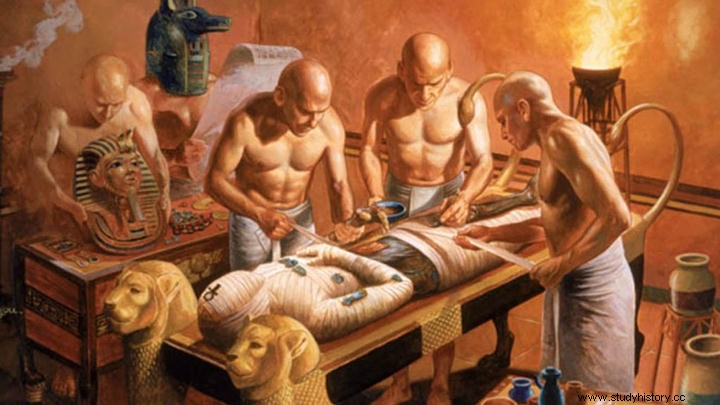
Pehernefer stopped for a second and with his hand motioned for me to come closer. He looked both ways and when he was sure that no one could hear us, he whispered in my ear:“cases have been discovered of embalmers who have abused corpses, and there are people who have decided that when the deceased are young women and beautiful, they prefer to leave the body at home for 3 days, until it begins to decompose, and thus avoid temptations ”. With that answer, it made sense that sometimes it is better not to know all the information.
Although at the time it did not seem the most appropriate, the scribe suggested that I taste a menu with the culinary delicacies of his land. There was no need to answer, because he already had everything planned and there he was the one in charge. So, he told me about all the dishes that were going to appear:a lettuce appetizer, a broad bean and barley soup, a pigeon stuffed with rice and accompanied by seasonal vegetables, roast beef, Nile fish prepared with skewers, and fig and nine cakes covered in honey; all washed down with beer. The truth is that it reminded me of those weddings in which, when you read the endless menu, you select which dishes you are going to eat and which ones you will avoid with a “thank you but I am full”. But here, with just two guests, there was no other choice but to comply with that oviparous banquet and my rotund host. We began to taste those delicacies, because the food was really very good, and I was chopping lettuce as a salad between courses.
-I see you like lettuce -commented the scribe with a half smile.
-Yes, it's not bad and, in addition, it degreases a little to be able to taste the rest of the dishes -I answered wondering the reason for that half smile.
-Hahahahahaha. I see you are not familiar with its properties. Lettuce is a sacred food and associated with Min, the god of fertility, and is a first-class aphrodisiac, which made men fall in love and makes women fertile. So, don't eat too much, you won't fall in love with any of the women who serve us.
And yes, again with the silly face that is being a constant on this trip. As best I could, I diverted the subject to the dish that, for my taste, had been the best:the pigeon stuffed with rice and the skewers that reminded me of those from my beloved Nerja in Malaga.
-I am glad that you liked it. A menu of these characteristics is only created for large celebrations or to entertain guests worthy of royal treatment. And so we have considered you. Let's finish with the desserts, rest for a while and continue the visit.
Cleopatra's food.
While we were eating the sweets, my attention was drawn to some women who were approaching the Nile with small baskets, some were picking up something on the shore, like mud, and others were pulling up some reeds on the shore. So, I asked about it.
-You are very curious Javier, very curious. Let's see how I explain it to you. The women do not collect mud, but crocodile droppings. Then, in their homes, they mix them with honey and apply a thin layer of this plaster to the cervix when they have sex so as not to get pregnant. And the women who collect the aquatic reeds do so because of how absorbent their stem is. When they have their period, they clean it, soften it and insert it to absorb the blood.
Come on, in Ancient Egypt they already had female contraceptives and tampons -I said to myself. With renewed energy and after having rested for a while, the procession continued on its way to a monument of the pharaoh erected next to the city. The drawings that were on the pedestal of that statue were going to help me, in theory, to know why human forms were made with the so-called "Egyptian profile".
-I have seen that in all your artistic representations of people they are all young, without wrinkles, beautiful and slender. Is it because there are few people who are over 40 or because you are very flirtatious and vain? -I jumped into the pool without looking first to see if there was water.
-Well, a bit of everything, really. In addition to the kohl you tried to eat before, we have different personal care treatments. In my case, for example, after a good scented bath, they spread olive oil and an abrasive substance on my body to exfoliate my skin; then, a moisturizing cream based on honey or moringa oil that also serves to relieve sunburn and remove stretch marks. And I end up applying a frankincense or cinnamon-based ointment to my armpits and a few drops of flower oil to my wig. There are other treatments, but I do not use them because they are very painful, such as removing facial wrinkles by rubbing the skin with a mixture of calcite powder and natron. It leaves your skin soft and rosy, but because it leaves your face raw.
At the same time that I thought that on his trips this good man would need an entire trunk for his vanity case, I asked him about the perspective of his drawings.
-The importance of the figures we represent has to do with size, the largest being those of our gods, then those of the pharaoh and so on, decreasing as the figures represent lower social classes. Dark skin color indicates that it is a man and light skin color is used for women. In addition, you will see that, depending on the part of the body, some are drawn from the front and others in profile:the head is shown in profile, although with a frontal view of the eyebrow and the eye; shoulders and torso frontally; while the hip and extremities recover the profile. Do not think that the artist draws a whole, but parts of a whole and each one of them is reflected with the view that best describes it and the importance they have within the whole. It's like a graphical representation of the Ba of it.
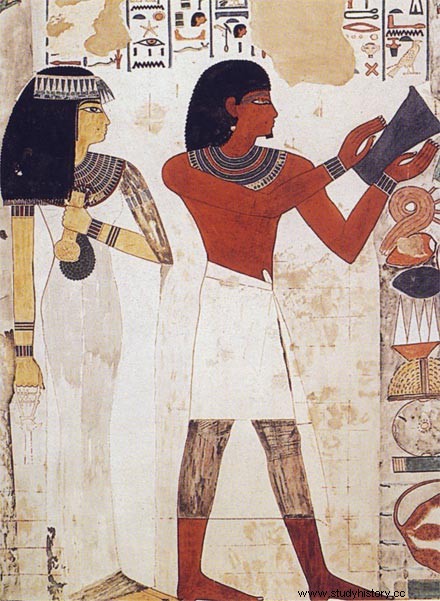
Although those drawings lacked depth and volume, the reality is that they went beyond a simple drawing, they had more to do with the magical and divine world that enveloped and permeated the entire Egyptian society. Now he would see those once deformed drawings with different eyes. It had been a master class in spiritual art. For my part, and seeing that the sun would soon set, I could end that fruitful trip. Pehernefer seemed to read my mind when he warned that they had to return before sunset. So, I went to my donkey, but the scribe caught my eye.
-Wait Xavier! I stayed here, the rest of the entourage will accompany you to the point where we picked you up. I have enjoyed this day in your company and I hope that the purpose of your trip has been fulfilled, my good friend.
-Fully Pehernefer. It has been a pleasure and I thank you for everything you have taught me -I replied while repeating the same ritual greeting as upon my arrival.
Since we couldn't move about the valley as we pleased without the scribe, the way back was much longer. Tired and with the battered crotch of that uncomfortable mount, I was grateful that one of the members of the retinue approached to offer me water. I drank and gratefully returned the skin. When he picked it up, he grabbed my hand and said, “The monument workers aren't slaves, but I am. I have seen that you asked about everything and I suppose that you will tell your people what you have seen here. Don't forget that the Egyptians also had slaves ”. He let go of my hand, ducked his head and slowed his pace to regain his position at the tail of the entourage. I made the mistake of turning my head and the one on the scribe's mount, who had been left in command, came up to me to ask if he had bothered me.
-Nerd. He only offered me water and apologized that it wasn't cooler - I excused him before that grumpy man who, surely, would not achieve eternal life in the kingdom of Osiris.
We picked up the pace, past the first house where I had the kohl mishap, and before long we reached my destination. They said goodbye and left me there just as I had come.
Source:Stories of History (Storytel)
My latest book is now on sale on Amazon:

